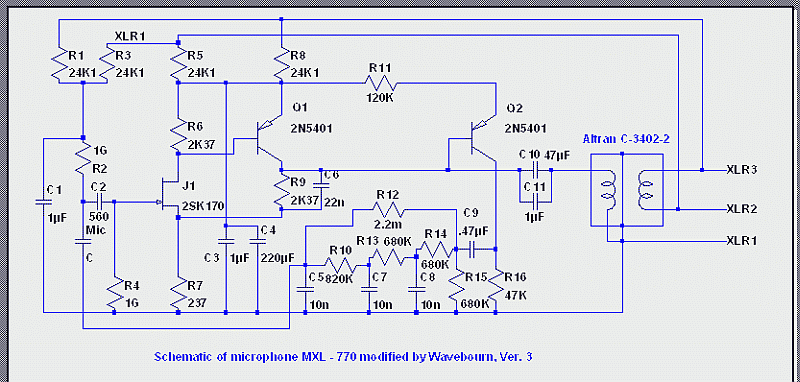SSLtech
Well-known member
The Schoeps design as realised by the Scott Dorsey mods, and as similarly implemented in the SD MXL mics, uses two 1-gig resistors. -And a small capacitor in between.
The capsule has one side grounded.
As I understand it, the capsule's "diaphragm" connection is pulled up towards the polarisation voltage by one of the 1-gig resistors and the capacitor blocks any discharging of the DC polarisation voltage. The second 1-gig resistor on the other side of the small cap keeps the gate of the FET at 0Volts DC or thereabouts... a little below the FET's source voltage at any rate.
Am I right so far?
If so, could you not simply omit one of the 1gig resistors and the cap inthe middle, by simply moving the "backplate" part of the capsule up to the polarisation voltage, and connecting the "diaphragm" connection straight to the gate, with a 1-gig resistor referring it to ground for DC purposes....
Why wouldn't this work? -I mean presuming that there's no permanently physically grounded part of the capsule and you have free rein to do as you wish...
Or would it work?
Surely each 1-gig resistor saps the signal amplitude slightly, or am I missing something? Using 2 resistors raises the apparent parallel load on the capsule to 500MegΩ, instead of one resistor loading the capsule by only 1000MegΩ.
Keith
The capsule has one side grounded.
As I understand it, the capsule's "diaphragm" connection is pulled up towards the polarisation voltage by one of the 1-gig resistors and the capacitor blocks any discharging of the DC polarisation voltage. The second 1-gig resistor on the other side of the small cap keeps the gate of the FET at 0Volts DC or thereabouts... a little below the FET's source voltage at any rate.
Am I right so far?
If so, could you not simply omit one of the 1gig resistors and the cap inthe middle, by simply moving the "backplate" part of the capsule up to the polarisation voltage, and connecting the "diaphragm" connection straight to the gate, with a 1-gig resistor referring it to ground for DC purposes....
Why wouldn't this work? -I mean presuming that there's no permanently physically grounded part of the capsule and you have free rein to do as you wish...
Or would it work?
Surely each 1-gig resistor saps the signal amplitude slightly, or am I missing something? Using 2 resistors raises the apparent parallel load on the capsule to 500MegΩ, instead of one resistor loading the capsule by only 1000MegΩ.
Keith




